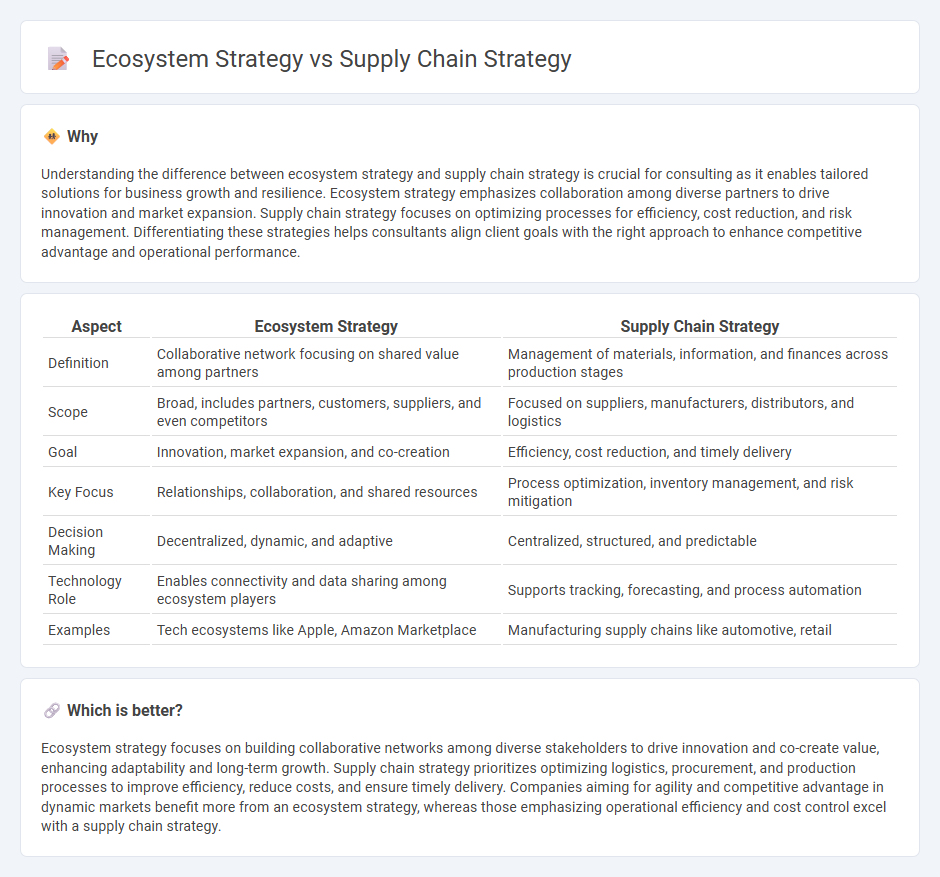
Ecosystem strategy focuses on creating value through interconnected partnerships and collaborative networks that drive innovation and competitive advantage. Supply chain strategy emphasizes optimizing the flow of goods, information, and resources to enhance efficiency, reduce costs, and improve customer satisfaction. Explore how aligning these strategies can transform business performance and resilience.
Why it is important
Understanding the difference between ecosystem strategy and supply chain strategy is crucial for consulting as it enables tailored solutions for business growth and resilience. Ecosystem strategy emphasizes collaboration among diverse partners to drive innovation and market expansion. Supply chain strategy focuses on optimizing processes for efficiency, cost reduction, and risk management. Differentiating these strategies helps consultants align client goals with the right approach to enhance competitive advantage and operational performance.
Comparison Table
| Aspect | Ecosystem Strategy | Supply Chain Strategy |
|---|---|---|
| Definition | Collaborative network focusing on shared value among partners | Management of materials, information, and finances across production stages |
| Scope | Broad, includes partners, customers, suppliers, and even competitors | Focused on suppliers, manufacturers, distributors, and logistics |
| Goal | Innovation, market expansion, and co-creation | Efficiency, cost reduction, and timely delivery |
| Key Focus | Relationships, collaboration, and shared resources | Process optimization, inventory management, and risk mitigation |
| Decision Making | Decentralized, dynamic, and adaptive | Centralized, structured, and predictable |
| Technology Role | Enables connectivity and data sharing among ecosystem players | Supports tracking, forecasting, and process automation |
| Examples | Tech ecosystems like Apple, Amazon Marketplace | Manufacturing supply chains like automotive, retail |
Which is better?
Ecosystem strategy focuses on building collaborative networks among diverse stakeholders to drive innovation and co-create value, enhancing adaptability and long-term growth. Supply chain strategy prioritizes optimizing logistics, procurement, and production processes to improve efficiency, reduce costs, and ensure timely delivery. Companies aiming for agility and competitive advantage in dynamic markets benefit more from an ecosystem strategy, whereas those emphasizing operational efficiency and cost control excel with a supply chain strategy.
Connection
Ecosystem strategy and supply chain strategy are intrinsically connected through their focus on collaborative networks that drive value creation and operational efficiency. By aligning ecosystem partnerships with supply chain processes, organizations enhance agility, innovation, and risk management across interconnected stakeholders. This integration enables seamless coordination, optimized resource allocation, and resilience in complex market environments.
Key Terms
Value Chain Optimization
Supply chain strategy concentrates on enhancing efficiency, reducing costs, and optimizing the flow of goods and information within a linear network of suppliers and distributors. Ecosystem strategy expands beyond traditional supply chains by fostering collaboration among diverse partners, including suppliers, customers, and complementary businesses, to create integrated value networks. Explore how value chain optimization differs in these approaches to maximize competitive advantage.
Network Collaboration
Supply chain strategy emphasizes optimizing internal processes and supplier relationships to enhance efficiency, cost control, and timely delivery within a linear framework. Ecosystem strategy expands this focus by fostering dynamic network collaboration among diverse partners, including suppliers, customers, and competitors, to drive innovation and create shared value. Explore the distinctions between supply chain and ecosystem strategies to unlock advanced approaches in network collaboration.
Competitive Advantage
Supply chain strategy emphasizes optimizing logistics, cost efficiency, and operational integration to build a competitive advantage through streamlined production and distribution. Ecosystem strategy focuses on collaboration, innovation, and value co-creation among interconnected partners to enhance market responsiveness and long-term sustainability. Explore how aligning these strategies can maximize your competitive edge in dynamic markets.
Source and External Links
Top Supply Chain Management Strategies for 2025 - A supply chain strategy should align with business objectives, assess current performance, choose an appropriate model (lean, agile, resilient, etc.), build resilience and flexibility, incorporate sustainability, and continuously measure and optimize for competitive advantage.
What Is A Supply Chain Strategy: Key Insights - enVista - Developing a supply chain strategy involves identifying business goals, setting key performance indicators, conducting cost-benefit analysis, and integrating advanced technologies like AI and IoT to improve visibility and efficiency.
2.1 Introduction to Supply Chain Strategy - Supply chain strategy is a functional strategy aligned with corporate and business unit strategies, formulated either top-down or bottom-up to guide sourcing, procurement, conversion, and logistics management while collaborating with partners.
 dowidth.com
dowidth.com